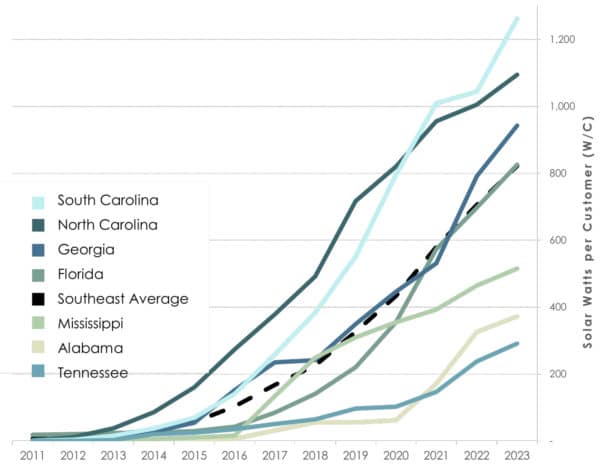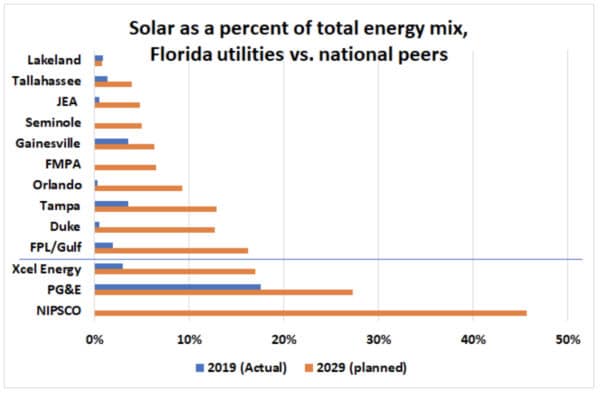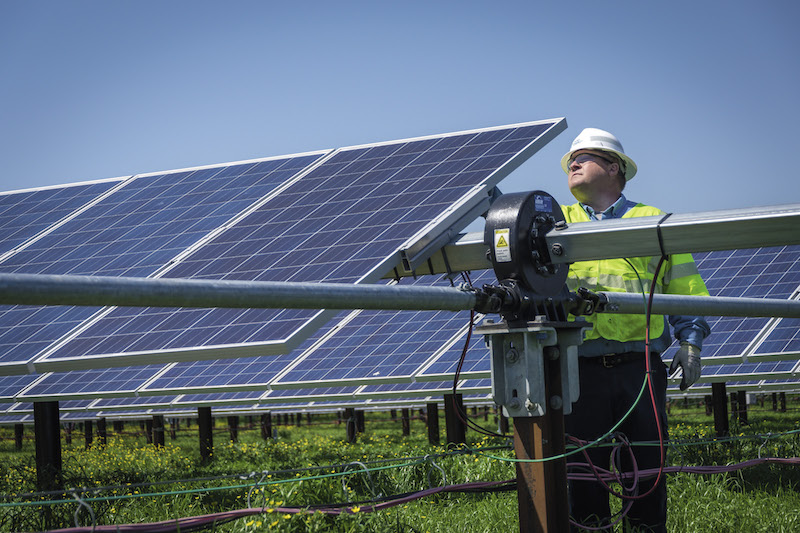Florida utilities plan to build “several gigawatts” of new gas units by 2029, beyond the 33 GW of gas units installed since 1990, said Vote Solar in comments on the plans.

Despite Florida utilities’ plans to add substantial new solar capacity, the number of solar watts per customer is expected to climb to only the regional average by 2023 (graph at right), said the Southern Alliance for Clean Energy in its comments. The pace of solar installations in the Carolinas and Georgia shows “the opportunity for additional solar ambition by Florida utilities,” the group said.

Vote Solar showed how Florida utilities’ solar plans for 2029, as a percent of generation, are outpaced by the plans of Xcel Energy, PG&E, and NIPSCO (graph at right).
Solar-plus-storage, with its high capacity value, is a direct competitor to gas, and in the western and central U.S., proposed solar-plus-storage capacity greatly exceeds proposed gas capacity. But beyond Florida Power & Light’s cost-saving plan to add 409 MW of 2.2-hour batteries to an existing solar plant, no other solar-plus-storage capacity had entered Florida’s interconnection queues by year-end 2019, a Lawrence Berkeley National Laboratory analysis found.
Vote Solar says that with FP&L’s planned battery addition, “battery storage has been demonstrated to be cost-effective in Florida,” and therefore state regulators “should question gas investments that are made by utilities whose planning lacks sophistication”—for example, planning that does not “fully consider all sub-hourly capacity and ancillary services benefits.”
Recommendations
The Southern Alliance for Clean Energy calls for greater investment by Florida utilities in energy efficiency and solar, partly to avoid the risk of stranded gas assets, as “it is reasonable to expect some sort of climate policy to emerge over the next decade.” Stranded gas assets—that is, gas assets shut down before they are fully depreciated—could leave customers paying higher electric bills, the group notes.
Vote Solar calls for Florida utilities to move “aggressively toward at least 30% renewable energy by 2030,” and to target customer energy efficiency gains of at least 1% per year.
Florida regulators, says Vote Solar, should exercise their legislatively granted authority, either to make comments and recommendations to the utilities regarding their current or future plans, or to reject unsuitable plans, or to request additional data from utilities.
Recipe for success
The Southern Alliance for Clean Energy calls for a “more robust, transparent, and participatory integrated resource plan (IRP) process,” backed up by all-source procurements. “Notably absent” from the current ten-year plans is an evaluation of “possible supply-side and demand-side alternatives,” the group says. “The lack of alternative plan information creates a regulatory ‘blind spot’” for regulators, while a stakeholder seeking to challenge a utility plan would often need to incur the costs to “re-create the utility’s internal analysis.” The group notes that some of its recommended improvements may require changes in state law.
Vote Solar suggests that Florida’s current regulatory approach is ineffective, as “only at the time of a future rate case would utilities be required to demonstrate the prudency” of the investments shown in their ten-year plans, “at which point ratepayer funds would already have been spent.” The group calls for the state to require “full integrated resource planning with transparency around least-cost, least-risk plans and alternatives.”
Vote Solar’s comments were written by staff members Katie Ottenweller, Odette Mucha and Tyler Fitch; the Southern Alliance for Clean Energy’s comments were a collaborative effort.
This content is protected by copyright and may not be reused. If you want to cooperate with us and would like to reuse some of our content, please contact: editors@pv-magazine.com.








By submitting this form you agree to pv magazine using your data for the purposes of publishing your comment.
Your personal data will only be disclosed or otherwise transmitted to third parties for the purposes of spam filtering or if this is necessary for technical maintenance of the website. Any other transfer to third parties will not take place unless this is justified on the basis of applicable data protection regulations or if pv magazine is legally obliged to do so.
You may revoke this consent at any time with effect for the future, in which case your personal data will be deleted immediately. Otherwise, your data will be deleted if pv magazine has processed your request or the purpose of data storage is fulfilled.
Further information on data privacy can be found in our Data Protection Policy.